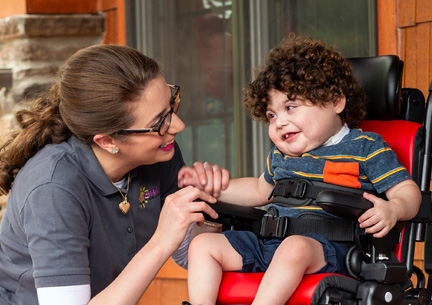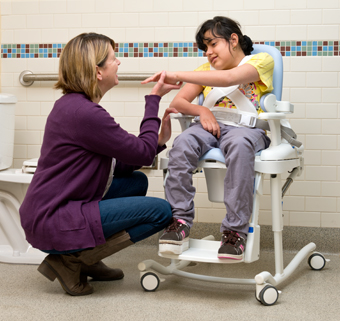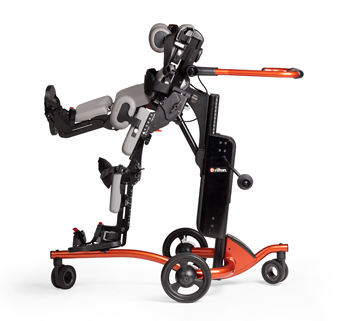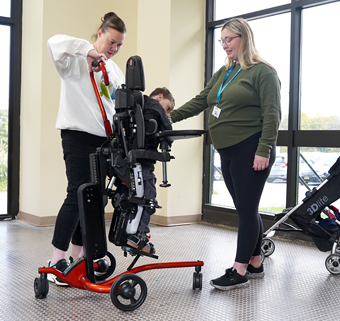Evidence Update: Stretching and Resistance Exercise in Children with CP
| August 2019 Improved joint range of motion (ROM) and strength certainly contribute to better functional outcomes in children with cerebral palsy (CP), but is stretching and progressive resistance exercise an adequate intervention to achieve the end? Previous research shows that children with CP have shorter hamstring muscles than their peers. A short or spastic hamstring muscle contributes to gait deviations, and hamstring-lengthening surgery doesn’t entirely solve the problem. These children also demonstrate decreased muscle strength contributing to overall difficulties in motor performance.
Improved joint range of motion (ROM) and strength certainly contribute to better functional outcomes in children with cerebral palsy (CP), but is stretching and progressive resistance exercise an adequate intervention to achieve the end? Previous research shows that children with CP have shorter hamstring muscles than their peers. A short or spastic hamstring muscle contributes to gait deviations, and hamstring-lengthening surgery doesn’t entirely solve the problem. These children also demonstrate decreased muscle strength contributing to overall difficulties in motor performance.
Because functional joint movement depends on both range of motion and muscle strength, the researchers of a recent randomized controlled trial opted to combine stretching of the hamstring muscles with terminal knee extension (TKE) strengthening exercises.1 With this they hoped to decrease the popliteal angle of the knee and thereby improve knee joint function and gross mobility in children with cerebral palsy.
Thirty-four children with bilateral spastic CP, recruited from the Norwegian CP follow-up program, participated in the study in either the intervention group or the comparison group. Inclusion criteria required participants to be at GMFCS levels I, II or III and without a recent history of lower limb surgery or botox injection.
Initial baseline testing was followed by 16 weeks of intervention including 3x/week of active and passive hamstring stretching in the supine and seated positions, step-ups, squats and heel raises with a back pack and manual resisted TKE. This was followed by a home-maintenance program once a week for 16 weeks.
Joint ROM Unchanged by Passive Stretch and Resistance Exercise
Results showed no significant between-group differences for both the active popliteal angle measurement and the passive popliteal angle measurement. This is in accordance with previous studies assessing the effects of passive stretching in children with CP.2,3 And although a small, non-clinically relevant improvement was noted in favor of the intervention group, the researchers point out the difficulty in justifying a time-consuming intervention when only small improvements are expected, especially since the small gains were not maintained after the home program (at 32 weeks).
In contrast, there is more and more research directing clinicians to intensively engage children with disabilities in context-focused and goal-directed therapy for best outcomes in gait and function as opposed to impairment-based treatment focus.4,5 This is additionally consistent with the goals and aims of the International Classification of Functioning Disability and Health (ICF). With this in mind then, the results of this study should not be too surprising, and they serve as a good reminder to spend our precious therapy time where it delivers the best results.
References
- Fosdahl ME, Jahnsen R, Kvalheim K, Holm I. Stretching and progressive resistance exercise in children with cerebral palsy: A randomized controlled trial. Pediatr Phys Ther. 2019;31:264-71.
- Wiart L, Darrah J, Kembhavi G. Stretching with children with cerebral palsy: what do we know and where are we going? Pediatr Phys Ther. 2008; 20(2): 173-8.
- Pin T, Dyke P, Chan M. The effectiveness of passive stretching in children with cerebral palsy. Dev Med Child Neurol. 2006; 48(10): 855-62.
- Booth A, Buizer A, Meyns P, Lansink I, Steenbrink F et al. The efficacy of functional gait training in children and young adults with cerebral palsy: a systematic review and meta-analysis. Dev Med Child Neurol. 2018; 60:866-83.
- 5. Novak I, McIntyre S, Morgan C, Campbell L, Dark L, Morton N et al. A systematic review of interventions for children with cerebral palsy: state of the evidence. Dev Med Child Neurol. 2013;55:885-910.




